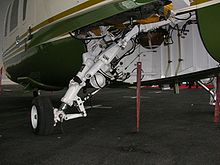Landing device
Landing devices are required for helicopters in order to take off and land vertically .
species
Landing skids
The landing skids ( Engl. Skids), the country most widely used device for helicopters. Due to their simple construction, these are easy to manufacture and mostly maintenance-free. Another advantage of the landing skids is the ability to absorb energy of up to 2 m / s in the event of a hard landing or a crash on the ground . Such landing devices for civil helicopters must comply with the Federal Aviation Regulations (FAR) Part 27 Section 725 Limit drop test for US manufacturers and EASA CS-27 Section 501 (both for small helicopters) applies to European helicopters . The construction of the landing skids normally consists of two holding tubes, which are attached across the fuselage , and two tubes along the length that form the skids . The materials for this are mostly aluminum 7075. In order to protect the runners from excessive wear, "shoes" are attached to their underside. In some cases (e.g. Enstrom helicopter, Schweizer 300C ) the landing skids are also equipped with shock absorbers. Landing skids are also available in a high version for uneven terrain, tall grass or structures under the fuselage. To move helicopters with skid landing gear on the ground and z. B. to be able to roll into the hangar, rollers are attached to the rear end of the runner, which can be pressed down with a lever (e.g. Robinson R22 , Bell 206 ).
This landing device offers several advantages over a wheeled landing gear. A skid landing gear weighs less and offers less air resistance than a fixed wheeled landing gear. Skids also reduce the risk of getting caught on objects on the ground (e.g. bushes). The disadvantage is that skid landing gear is more susceptible to ground resonance .
Fixed chassis
Fixed wheels are mainly found in larger helicopters that have to be moved on the ground (e.g. the Sikorsky UH-60 on aircraft carriers ). The most common arrangement of the landing gear is the three-legged one. With these undercarriages and heavier helicopters, it is possible to use double tires . These chassis are equipped with shock absorbers and brakes. Another advantage is the fact that the helicopter can roll on the ground with a low engine power and does not have to move in hover . The helicopter is controlled via the pedals (for the tail rotor ), which act on the left and right brakes of the respective wheel on the ground. The nose wheel can usually be swiveled freely through 360 degrees and is locked before the helicopter takes off .
Retractable landing gear

The retractable gear is often used in helicopters, which are mainly used in business areas (e.g. Agusta A109 , Bell 222 , Sikorsky S-76 ). Some military helicopters also have retractable landing gears, e.g. B. Mil Mi-24 , Kamow Ka-50 and Ka-52 .
Despite the increased maintenance requirements and higher weight, the advantage of lower air resistance and the resulting higher speed and lower fuel consumption when retracted prevail. In some military developments (e.g. Boeing-Sikorsky RAH-66 ), reducing the radar signature was also an argument.
Landeski
Wide country skis (helicopter skis) are ski runners intended for alpine use in snow when wheels or runners are not possible and prevent the helicopter from sinking into soft ground (snow, sand).
Water vats
Water runners (English. Floats) are floating bodies to land the helicopter on the water. In contrast to seaplanes , helicopters do not normally need their own license, but flying skills are still required, as there is no frictional resistance on the ground when the rotor rotates as is the case with runners and the torque that occurs must therefore be compensated in good time. One differentiates:
- Fixed float on the runners (English float-on-skid)
 Robinson R44 clipper with inflatable floats
Robinson R44 clipper with inflatable floats - Fixed float under the runners (skid-on-float)
- Inflatable emergency pop-out floats
literature
- Walter Bittner: Flight mechanics of the helicopter. Technology, the flight dynamics system helicopters, flight stability, controllability. 2nd updated edition. Springer, Berlin et al. 2005, ISBN 3-540-23654-6 .
Individual evidence
- ↑ Landinggear design investigation by Kshitij Shrotri, School of Aerospace Engineering, Georgia Institute of Technology, August 2008
- ↑ Information at Aircraftspruce.com (English)
